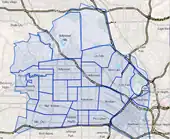Central Los Angeles
Central Los Angeles is the historical urban region of the City of Los Angeles, California.
Central Los Angeles | |
|---|---|
Region of Los Angeles | |
| Country | United States |
| State | California |
| County | Los Angeles County |
| City | Los Angeles |
Geographic designation by The City of Los Angeles
The Los Angeles Department of City Planning divides the city into Area Planning Commission (APC) areas, each further divided into Community Plan areas (CPAs).
The Central Los Angeles APC area is made up of the following six CPAs:[1][2]
- Central City CPA
- Central City North CPA
- Hollywood CPA
- Westlake CPA
- Wilshire CPA
Each CPA is divided by neighborhood council, though a neighborhood council can cover an area in more than one CPA.[3][4] Neighborhoods within each CPA include the following:
Central City CPA[5]
Central City North CPA[6]
Wilshire CPA[7]
- Wilshire Center
- Koreatown
- Hancock Park
- Windsor Square
- Larchmont
- Mid-Wilshire
- Mid-City
- Beverly–Fairfax
- Carthay
- Pico–Robertson (partly)
Hollywood CPA[8]
- Bird Streets
- Beachwood Canyon
- East Hollywood
- Hollywood
- Hollywood Hills
- Laurel Canyon (partly)[9]
- Little Armenia
- Los Feliz
- Thai Town
Westlake CPA[10]
- Westlake
- Historic Filipinotown
- Temple–Beaudry
Geographic designation by Mapping L.A. Project
According to the Mapping L.A. survey of the Los Angeles Times, the Central Los Angeles region constitutes 57.87 sq mi (149.9 km2) and comprises twenty-three neighborhoods within the City of Los Angeles, as well as Griffith Park, the city's largest public park. In Mapping L.A., the Central Los Angeles region consists of:[11]

- Arlington Heights
- Beverly Grove
- Carthay
- Chinatown
- Downtown
- East Hollywood
- Echo Park
- Elysian Park
- Elysian Valley
- Faircrest Heights
- Griffith Park
- Hancock Park
- Harvard Heights
- Hollywood
- Hollywood Hills
- Hollywood Hills West
- Koreatown
- Larchmont
- Los Feliz
- Mid-City
- Mid-Wilshire
- Pico-Union
- Silver Lake
- West Hollywood
- Westlake
- Windsor Square
Population
The following data applies to Central Los Angeles within the boundaries set by Mapping L.A.:
In the 2000 United States Census, Central Los Angeles had 836,638 residents in its 57.87 sq mi (149.9 km2), including the uninhabited Griffith and Elysian parks, which amounted to 14,458 people per square mile. The densest neighborhood was Koreatown, and the least dense was Elysian Park.[11] The four densest regions by population were in Central Los Angeles: Koreatown with 42,611 residents per square mile, followed by Westlake, 38,214; East Hollywood, 31,095, and Pico-Union, 25,352.[12]
About 81% of the area's population lived in rental units, while 19% lived in owner-occupied housing. Westlake was the neighborhood with the highest rental occupancy, and Hollywood Hills West had the lowest. The latter district also had the oldest population, and Pico-Union had the youngest. Hollywood Hills West also was the wealthiest neighborhood, and Downtown was the poorest. Hollywood Hills West was the neighborhood with the largest percentage of residents holding a four-year academic degree, and Pico-Union had the lowest percentage.[11] The ethnic breakdown in 2000 was Latino 46.1%; white 26.4%, Asian 16.2%; black 8.2%, and other 3.1%. Mid-Wilshire was the most ethnically diverse neighborhood and Pico-Union the least.[11]
References
- "ZIMAS". zimas.lacity.org.
- "Zoning Areas Map of Los Angeles County, CA | PropertyShark.com". www.propertyshark.com.
- "City Map".
- "Councils By Commission Area".
- "Historic Resources Survey Report: Central City Community Plan Area" (PDF). City of Los Angeles. September 2016. Retrieved 2020-10-01.
- "Historic Resources Survey Report: Central City North Community Plan Area" (PDF). City of Los Angeles. September 2016. Retrieved 2020-10-01.
- "Los Angeles City Planning" (PDF). Home. 2020-06-05. Retrieved 2020-08-08.
- "Los Angeles City Planning" (PDF). Home. 2020-06-05. Retrieved 2020-08-08.
- "DEPARTMENT OF CITY PLANNING RECOMMENDATION REPORT" (PDF). planning.lacity.org. January 25, 2018. Retrieved 2020-08-08.
- "Los Angeles City Planning" (PDF). Home. 2020-06-05. Retrieved 2020-08-08.
- "Central L.A." Mapping L.A.
- "Density," Mapping L.A., Los Angeles Times
See also
Other regions of Los Angeles County